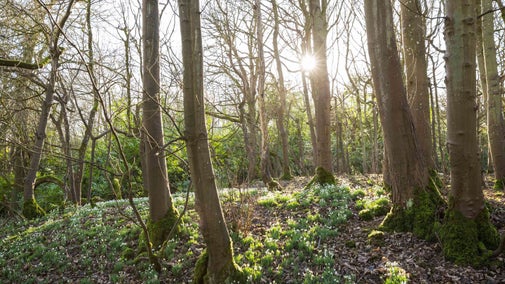
Discover more at Maidenhead and Cookham Commons
Find out how to get to Maidenhead and Cookham Commons, where to park, the things to see and do and more.

The Cookham Commons are a series of grassland and woodland commons, offering great walks and impressive views over the rural landscape of Berkshire. Discover what you can see at each common, from Widbrook and Cock Marsh to the Commons of Cookham Dean, and find the best places for wildlife spotting here.
At the very heart of Cookham Village you’ll find Cookham Moor, often a hub for local events and fêtes, and a haven for wildlife thanks to its carefully managed habitats. The verges are a great place to go bug hunting for beetles and other insects, and on quieter days you may be lucky enough to see a kingfisher perched above the pond.
Cookham Moor is a good starting point for an extended walk along the River Thames to Cock Marsh. Alternatively, head south into the quieter countryside, criss-crossed by the Strand Water and White Brook streams. This walk is also the best way to venture onto Widbrook Common.
Local to Cookham, the works of artist Stanley Spencer capture the tranquillity of everyday village life and the rural idyll of the surroundings. Take in the history and culture of Cookham Village by combining a walk in the countryside with a visit to Cookham church and the Stanley Spencer Gallery.
Situated on the banks of the River Thames, opposite the town of Bourne End, the chalk grasslands of Cock Marsh make for a pleasant riverside stroll. Follow the footpaths weaving through the grasses and wildflowers or climb to the top of the chalk slope to discover far-reaching views over the Buckingham countryside.
In summer, cows graze the meadows, encouraging wildflowers and orchids to grow here. You may also find rock roses, thyme, and a rare plant called brown galingale. Cock marsh is one of only 12 sites in the UK where you can find brown galingale, now an endangered species.
Cock Marsh is home to four circular Bronze Age burial mounds (tumuli). When first created, the largest barrow had a diameter of 90 feet, and would have been around eight feet high. Today, although much diminished, you can still see the largest mound.
Grazed by commoners since time immemorial, the pretty stream of White Brook (or Widbrook) winds its way through these pastures. The name derives from the stream’s traditional name, Withe Brooke, which refers to the ‘withe’ or willow trees that are found along the banks of the stream.
Widbrook is still grazed by local commoners between May and October, which has created a diverse habitat for insects and birds.
The best way to explore Widbrook Common is to venture south from Cookham Moor, away from the bustling Thames-side village of Cookham into quieter countryside.
Winter Hill offers some of the most breath-taking views of the river Thames and nearby Cock Marsh. One of the highest Thames terraces, Winter Hill is believed to have been used as winter pasture for livestock when more fertile areas on the flood plains became unstable – thus its name, ‘winter hill’.

The commons of Cookham Dean consist of various road verges, village greens, small parcels of woodland and a disused quarry, creating a chain of grassland habitats through the landscape.
The main car park is located at Cookham Dean Common, the largest of the grasslands, making it an excellent place to start exploring. From here you can wander through the Cricket Common, Cookham Dean Chalk Pit, Bigfrith Common, Hardings Green Common and Tugwood Common.
Highlights include far-ranging views from the Cricket Common, 16th-century architecture at Hardings Green Common, and rural landscapes at Tugwood Common that inspired the adventures of Ratty, Mole and Toad, in the book The Wind in the Willows, written by Kenneth Grahame while he lived at Cookham Dean.
There are plenty of walks and footpaths that you can follow to take in the various landscapes of the Cookham Dean Commons.

Find out how to get to Maidenhead and Cookham Commons, where to park, the things to see and do and more.
Find an abundance of wildflowers, peaceful woodland walks and plenty of wildlife all year round at Maidenhead Commons, the hidden gems of the Berkshire countryside.

Find out how we protect and preserve around 500 acres of grassland and 340 acres of woodland habitat at Maidenhead and Cookham Commons, Berkshire.

From Bronze Age burial grounds to industrial brick works, discover the history of the pockets of rural land at Maidenhead and Cookham Commons.

Learn about some of the interesting characters who have lived and travelled in and around Maidenhead and Cookham Commons in Berkshire.

Discover the fascinating and contentious history of commons, natural green spaces that were once used by the community before many were enclosed by private landowners.

Plan a visit to one of the special countryside places in our care and discover the benefits of being in the great outdoors. Pack your walking boots and get ready to explore woodlands, valleys and rivers.

Explore some of the finest landscapes in our care on coastal paths, accessible trails, woodland walks and everything in between. Find the best places to walk near you.

From dappled beech woodlands to wildflower-rich chalk grasslands in The Chilterns, a wide variety of countryside landscapes awaits you across Oxfordshire, Buckinghamshire and Berkshire.
